Great choice! Your favorites are temporarily saved for this session. Sign in to save them permanently, access them on any device, and receive relevant alerts.
- Sailboat Guide
DS-22 is a 21 ′ 8 ″ / 6.6 m monohull sailboat designed by Bruce Kirby and built by DS Yachts (Schwill Yachts) starting in 1983.

Rig and Sails
Auxilary power, accomodations, calculations.
The theoretical maximum speed that a displacement hull can move efficiently through the water is determined by it's waterline length and displacement. It may be unable to reach this speed if the boat is underpowered or heavily loaded, though it may exceed this speed given enough power. Read more.
Classic hull speed formula:
Hull Speed = 1.34 x √LWL
Max Speed/Length ratio = 8.26 ÷ Displacement/Length ratio .311 Hull Speed = Max Speed/Length ratio x √LWL
Sail Area / Displacement Ratio
A measure of the power of the sails relative to the weight of the boat. The higher the number, the higher the performance, but the harder the boat will be to handle. This ratio is a "non-dimensional" value that facilitates comparisons between boats of different types and sizes. Read more.
SA/D = SA ÷ (D ÷ 64) 2/3
- SA : Sail area in square feet, derived by adding the mainsail area to 100% of the foretriangle area (the lateral area above the deck between the mast and the forestay).
- D : Displacement in pounds.
Ballast / Displacement Ratio
A measure of the stability of a boat's hull that suggests how well a monohull will stand up to its sails. The ballast displacement ratio indicates how much of the weight of a boat is placed for maximum stability against capsizing and is an indicator of stiffness and resistance to capsize.
Ballast / Displacement * 100
Displacement / Length Ratio
A measure of the weight of the boat relative to it's length at the waterline. The higher a boat’s D/L ratio, the more easily it will carry a load and the more comfortable its motion will be. The lower a boat's ratio is, the less power it takes to drive the boat to its nominal hull speed or beyond. Read more.
D/L = (D ÷ 2240) ÷ (0.01 x LWL)³
- D: Displacement of the boat in pounds.
- LWL: Waterline length in feet
Comfort Ratio
This ratio assess how quickly and abruptly a boat’s hull reacts to waves in a significant seaway, these being the elements of a boat’s motion most likely to cause seasickness. Read more.
Comfort ratio = D ÷ (.65 x (.7 LWL + .3 LOA) x Beam 1.33 )
- D: Displacement of the boat in pounds
- LOA: Length overall in feet
- Beam: Width of boat at the widest point in feet
Capsize Screening Formula
This formula attempts to indicate whether a given boat might be too wide and light to readily right itself after being overturned in extreme conditions. Read more.
CSV = Beam ÷ ³√(D / 64)
A boat nearly the same as this was originally sold as the VISION 660.
Embed this page on your own website by copying and pasting this code.
Discover Related Sailboats
- About Sailboat Guide
©2024 Sea Time Tech, LLC
This site is protected by reCAPTCHA and the Google Privacy Policy and Terms of Service apply.
The Ds 22 is a 21.67ft masthead sloop designed by Bruce Kirby and built in fiberglass by DS Yachts (Schwill Yachts) (CAN) since 1983.
The Ds 22 is a light sailboat which is a good performer. It is stable / stiff and has a low righting capability if capsized. It is best suited as a day-boat.
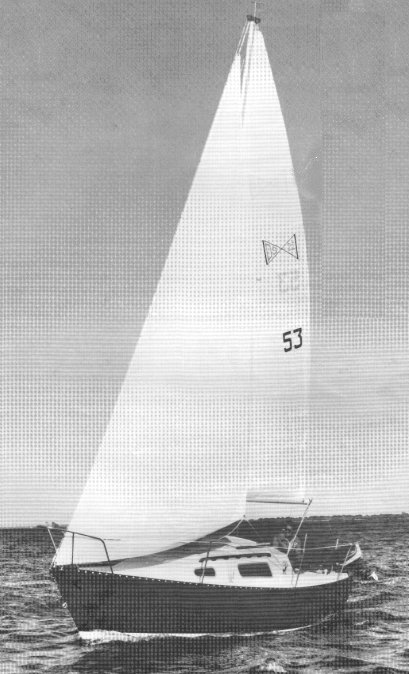
Ds 22 for sale elsewhere on the web:

Main features
Login or register to personnalize this screen.
You will be able to pin external links of your choice.

See how Sailboatlab works in video

We help you build your own hydraulic steering system - Lecomble & Schmitt
Accommodations
Builder data, other photos, modal title.
The content of your modal.
Personalize your sailboat data sheet

- Forum Listing
- Marketplace
- Advanced Search
- About The Boat
- Boat Builders Row
- Other Brands
- SailNet is a forum community dedicated to Sailing enthusiasts. Come join the discussion about sailing, modifications, classifieds, troubleshooting, repairs, reviews, maintenance, and more!
- Add to quote
I just bought a DS 22. These must not have been overly popular boats. I can't seem to find any manuals or information on her anywhere. I can't even find out how to raise or lower the swing keel. If anyone can point me in the right direction I would be appreciative.
I Googled name of the boat and found a discussion board with a number of members listed. There are email addresses to several. The discussion is quite a few years old, however. There were a couple of comments regarding the swing keel, saying that they were made of steel and are prone to getting rusted stuck. People say they sail well even with the swing board up. http://forums.voileabordable.com/read.php?2,1033
I looked at a DS22 down near Montreal this winter. I was fascinated by the fact that they are a Bruce Kirby design. In my research I read about a lot of problems with the swing keel getting stuck in the trunk in the spring. If you're having trouble lowering your keel, I don't think you are the first DS 22 owner to have that problem. It seems as though most owners have a way of dealing with the issue, but they all seem to be a little different. I have never owned one, just did a bunch of reading on them. I see on your profile that you are in Minden, the flooding there is insane this year. I hope your house is no where near the river.
Thanks again Arcb. I have been reading about the sticking swing keel too, There seems to be a few different fixes I can try. Yes, the flooding is bad in Minden again, it seems to happen every couple of years. I've been up here 7 years and this is the third time I've seen it. Some of the olditimers say that the whole town is built on swampland and is a flood plain, they may be right.
Thanks midwesterner, I checked out the discussion board you mentioned. Seems 2 things stand out 1 The swing keel is problematic and, 2 most owners are very pleased with their boats. They did have a few fixes to try. Good news is I found the keel winch, it is in the stbd cockpit locker, I never would have guessed!
No wonder you couldn't find it! That's bizarre. I've heard that the dam and white water park just upriver have resulted in serious silting and there has been something like a 50% reduction in volume the river is capable of holding between the white water park and Gull Lake. Not sure if it's true or not, I remember high water when I was a kid, but not major flooding.
I know that the white water park is wild at this time of year usually, I haven't been over that way for about a month now though. As most of the Haliburton lakes are reservoir lakes for the Trent system, people along those waterways blame Parks Canada for mismanaging the water levels, be they to high or to low. I would not be surprised if there is a silting issue on that stretch. I was totally reworked for the Pan/Am ganes last year and tons of fill was dumped in to make the water course more challenging.
For what it's worth, the DS-22 was built by DS Yachts in Odessa, Ontario (Not far from where I live!) Also at times called Schwill Yachts and owned by Herman Schwil. Shop is no longer there and I have not heard of Herman for quite a while. Not sure if he is still with us. They also built a number of other boats. This information is not complete: Sailboats built by DS Yachts (Schwill Yachts) (CAN) by year on Sailboatdata.com . They also built a couple of small Kirby more racy boats. Rusty swing keels are not uncommon. Need to get boat up high and get keel down where you can work on it. Scrape off all loose rust. Maybe use a wire wheel. Once clean, give it a couple of coats of POR-15, fill any cavities with epoxy filler then paint with an epoxy barrier paint and/or antifouling paint if boat will be left in water. Good Luck with it.
Hi FreeAgent, Thanks for the info and suggested repair. I think I will launch her next week after a good scrub. I don't really know if the keel is stuck or not as she is still on the trailer. If it is stuck I guess I'll have the marina lift her and rent a cradle for a week or so.
- ?
- 173.8K members
Top Contributors this Month
Not logged in
- Create account
Engineering:DS-22
- Engineering
Page actions
- View source
The DS-22 is a Canadian trailerable sailboat , that was designed by Bruce Kirby and first built in 1983. [1] [2] [3]
The DS-22 is a development of the 1976 Vision 660. [1]
- 1 Production
- 3 Operational history
- 5 References
- 6 External links
The boat was built by Diller-Schwill in Odessa, Ontario, Canada , but it is now out of production. [1] [4]
The DS-22 is a small recreational keelboat , built predominantly of fiberglass , with wood trim. It has a masthead sloop rig, a transom-hung rudder and a fixed keel with a centreboard . It displaces 2,400 lb (1,089 kg) and carries 890 lb (404 kg) of ballast. [1] [2]
The boat has a draft of 4.50 ft (1.37 m) with the centreboard extended and 2.0 ft (0.61 m) with it retracted. [1]
The boat is normally fitted with a small outboard motor for docking and maneuvering. [1]
The boat has a PHRF racing average handicap of 255 with a high of 252 and low of 258. It has a hull speed of 5.76 kn (10.67 km/h). [2]
Operational history
In a review Michael McGoldrick wrote, "The DS 22 is good looking boat with a swing keel and sensible cabin layout. Some of these boat were built with a main hatch which lifted to provide over 6 feet (1.9m) of headroom in the cabin." [5]
- List of sailing boat types
Related development
Similar sailboats
- Cape Dory 22
- Catalina 22
- Falmouth Cutter 22
- Marlow-Hunter 22
- Marshall 22
- Pearson Electra
- Pearson Ensign
- Spindrift 22
- Starwind 223
- US Yachts US 22
- ↑ 1.0 1.1 1.2 1.3 1.4 1.5 Browning, Randy (2017). "DS-22 sailboat specifications and details" . sailboatdata.com . https://sailboatdata.com/sailboat/ds-22 . Retrieved 4 June 2017 .
- ↑ 2.0 2.1 2.2 InterVisionSoft LLC (2017). "Sailboat Specifications for DS 22" . Sailing Joy . http://www.sailingjoy.com/sailboat_specs/sailboat_specs/view/264/ds-22 . Retrieved 4 June 2017 .
- ↑ Browning, Randy (2017). "Bruce Kirby" . sailboatdata.com . https://sailboatdata.com/designer/kirby-bruce . Retrieved 4 June 2017 .
- ↑ Browning, Randy (2017). "DS Yachts (Schwill Yachts) (CAN) 1971-1986" . sailboatdata.com . https://sailboatdata.com/builder/ds-yachts-schwill-yachts-can . Retrieved 4 June 2017 .
- ↑ McGoldrick, Michael (2018). "DS 22" . Sail Quest . http://sailquest.com/market/models/ds22.htm . Retrieved 24 July 2018 .
External links
- Sailing yachts
- Trailer sailers

- Add a new article
- Search in all topics
- Search in namespaces
- Search in categories
- Search using prefix
- About HandWiki
- How to edit
- Citation manager
- Formatting articles
- List of categories
- Recent pages
- Recent changes
- Random page
- Support & Donate
- Special pages
- Cite this page
User page tools
- What links here
- Related changes
- Printable version
- Permanent link
- Page information
Other projects
In other languages.
- This page was last edited on 11 July 2022, at 03:11.
- Privacy policy
- Disclaimers
Review of Vision 660
Basic specs., sailing characteristics.
This section covers widely used rules of thumb to describe the sailing characteristics. Please note that even though the calculations are correct, the interpretation of the results might not be valid for extreme boats.
What is Capsize Screening Formula (CSF)?
The capsize screening value for Vision 660 is 2.39, indicating that this boat would not be accepted to participate in ocean races.
What is Theoretical Maximum Hull Speed?
The theoretical maximal speed of a displacement boat of this length is 5.8 knots. The term "Theoretical Maximum Hull Speed" is widely used even though a boat can sail faster. The term shall be interpreted as above the theoretical speed a great additional power is necessary for a small gain in speed.
The immersion rate is defined as the weight required to sink the boat a certain level. The immersion rate for Vision 660 is about 92 kg/cm, alternatively 516 lbs/inch. Meaning: if you load 92 kg cargo on the boat then it will sink 1 cm. Alternatively, if you load 516 lbs cargo on the boat it will sink 1 inch.
Sailing statistics
This section is statistical comparison with similar boats of the same category. The basis of the following statistical computations is our unique database with more than 26,000 different boat types and 350,000 data points.
What is Motion Comfort Ratio (MCR)?
What is L/B (Length Beam Ratio)?
What is Displacement Length Ratio?
What is SA/D (Sail Area Displacement ratio)?
Maintenance
Are your sails worn out? You might find your next sail here: Sails for Sale
If you need to renew parts of your running rig and is not quite sure of the dimensions, you may find the estimates computed below useful.
This section shown boat owner's changes, improvements, etc. Here you might find inspiration for your boat.
Do you have changes/improvements you would like to share? Upload a photo and describe what to look for.
We are always looking for new photos. If you can contribute with photos for Vision 660 it would be a great help.
If you have any comments to the review, improvement suggestions, or the like, feel free to contact us . Criticism helps us to improve.
- New Sailboats
- Sailboats 21-30ft
- Sailboats 31-35ft
- Sailboats 36-40ft
- Sailboats Over 40ft
- Sailboats Under 21feet
- used_sailboats
- Apps and Computer Programs
- Communications
- Fishfinders
- Handheld Electronics
- Plotters MFDS Rradar
- Wind, Speed & Depth Instruments
- Anchoring Mooring
- Running Rigging
- Sails Canvas
- Standing Rigging
- Diesel Engines
- Off Grid Energy
- Cleaning Waxing
- DIY Projects
- Repair, Tools & Materials
- Spare Parts
- Tools & Gadgets
- Cabin Comfort
- Ventilation
- Footwear Apparel
- Foul Weather Gear
- Mailport & PS Advisor
- Inside Practical Sailor Blog
- Activate My Web Access
- Reset Password
- Pay My Bill
- Customer Service

- Free Newsletter
- Give a Gift

How to Sell Your Boat

Cal 2-46: A Venerable Lapworth Design Brought Up to Date

Rhumb Lines: Show Highlights from Annapolis

Open Transom Pros and Cons

Leaping Into Lithium

The Importance of Sea State in Weather Planning

Do-it-yourself Electrical System Survey and Inspection

Install a Standalone Sounder Without Drilling

When Should We Retire Dyneema Stays and Running Rigging?


Rethinking MOB Prevention

Top-notch Wind Indicators

The Everlasting Multihull Trampoline

How Dangerous is Your Shore Power?

DIY survey of boat solar and wind turbine systems

What’s Involved in Setting Up a Lithium Battery System?

The Scraper-only Approach to Bottom Paint Removal

Can You Recoat Dyneema?

Gonytia Hot Knife Proves its Mettle

Where Winches Dare to Go

The Day Sailor’s First-Aid Kit

Choosing and Securing Seat Cushions

Cockpit Drains on Race Boats

Rhumb Lines: Livin’ the Wharf Rat Life

Re-sealing the Seams on Waterproof Fabrics

Safer Sailing: Add Leg Loops to Your Harness

Waxing and Polishing Your Boat

Reducing Engine Room Noise

Tricks and Tips to Forming Do-it-yourself Rigging Terminals

Marine Toilet Maintenance Tips

Learning to Live with Plastic Boat Bits
- Sailboat Reviews
Like the Volkswagen Beetle, this pocket cruiser has been much refined over the years. While most of the innovations are clever, some, at least occasionally, are a bother.
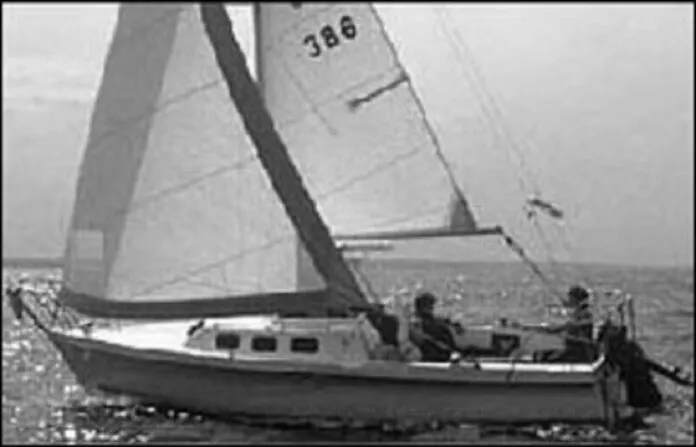
As with many of our used boat reports, we invited owners of the Rhodes 22 to comment on its design, construction, quality of workmanship, performance, and customer service from the factory. We received a greater response, and a more uniformly enthusiastic response, than we’ve had to any similar request in recent years. Impressive, especially when you consider that only 50 of these boats are built each year. When we got an opportunity to take one out and put it through its paces, we gained some insight into just what prompted all this loyalty.
Designed by Phillip Rhodes back in 1960, the Rhodes 22 is a trailerable cruiser for a couple that wants the amenities of a larger boat without putting up with the hassles and expenses of a larger boat. It’s clearly not a racing boat. It’s also not a “shoehorn special,” whose claim to fame is how many persons it can sleep. And it’s not an inexpensive boat for its size. The Rhodes 22, from its inception, has been a purpose-built boat. And, with a history of detail improvements and some innovative thinking, it meets that purpose quite well.
The Rhodes 22 has a fairly long waterline—20′. Overhangs are minimal. This is clearly the first step towards cramming a lot of cruising conveniences into what is, after all, a small boat.
The most readily noticeable feature of its hull is a pronounced flare at the gunwales, much like that found on a 505 or similar racing dinghy. The look is odd on a keelboat, but the flare provides a few notable advantages: The compound curvature stiffens the hull, provides a hiking seat to reduce heeling, helps deflect spray, and provides some extra buoyancy when the boat is heeled over, helping to prevent capsize, according to Stan Spitzer, the owner of General Boats.
Unlike most trailerable sailboats sold today, the Rhodes 22 uses neither a swing keel nor water ballast. Instead, there’s a shoal keel with a centerboard built in. With the board up, the boat draws 20″; 48″ with the board down.
Compared to a swing keel, this arrangement may lose a bit of stiffness because the keel’s weight is carried higher; but it has the advantages of eliminating the swing keel’s highly stressed pivot pin as well as the necessity for a winch and a cable to haul up the keel (which may hum annoyingly when you’re underway).
Compared to water ballast of the same weight, the shoal keel/centerboard arrangement carries its weight lower, making the boat stiffer. In any case, the Rhodes 22 can be sailed in 20″ of water with the board up; it sails just fine that way, though it can’t point as high as it can with the board down. The board is designed to kick up if it strikes an obstruction.
The 100-sq. ft. mainsail rolls up into a 26′ mast and a 175% 200-sq. ft. genoa is roller-furled on the forestay. The arrangement does not make the most efficient sail shape, particularly with a partially-furled jib in heavier weather, and without battens to support a large mainsail roach. But it’s hard to argue with the convenience of this rig. A less-obvious advantage is that you don’t have to deal with the problem of finding a place to store bulky sailbags belowdecks.
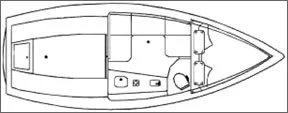
The Rhodes 22 makes up for whatever loss of sail efficiency may be caused by its furling features by providing a generous 300 sq. ft. of sail. Other sail options are available, including a self-tending jib and conventional hank-on sails.
The hinged mast is well-supported by a forestay, a pair of backstays, upper shrouds, forward and aft lowers. Each of these has its own chainplate. One nice thing about having all this standing rigging is that the loss of any one stay shouldn’t bring the mast crashing down. (If the forestay breaks, the forward lower shrouds hopefully will keep the mast up until you can jury-rig a new forestay.)
Chainplates are mounted solidly. The forestay’s padeye is through-bolted to the deck and hull, while the two backstay plates are bolted through the corners of the transom. The upper shroud chainplates are bolted through the hull-deck joint, while the four lower shroud chainplates are glassed into the cabin top. This location provides a “corridor” between the upper and lower shrouds that facilitates movement fore and aft on deck.
Construction
The Rhodes 22’s construction is best described as conventional, with good attention to detail. The hull is laid up with a layer of chop on the skin, followed by a layer of roving, followed by Coremat. The deck uses a glass syntactic foam core, making it and the cabin top about 1″ thick.
Twenty-five different molds provide finished surfaces where otherwise none would exist. The lazarette hatch, for example, has a finished liner instead of a rough fiberglass surface, and coaming compartments have finished, built-in storage shelves. Galley doors are molded in two separate sections and cemented together to avoid warping.
The hull-to-deck joint is a “shoebox” design, with a vertical deck flange slipping over the hull. The joint is screwed together with stainless steel fasteners and then caulked. There are heavier through-bolts at the bow and stern, and at chainplate areas, which are preferable. The joint is covered with a rub rail.
The Rhodes 22 has two molded foam sections glassed into the hull; one under the forward bunk and one under the cockpit sole. Spitzer said that these make the boat unsinkable, an important safety feature not found in most small cruisers.
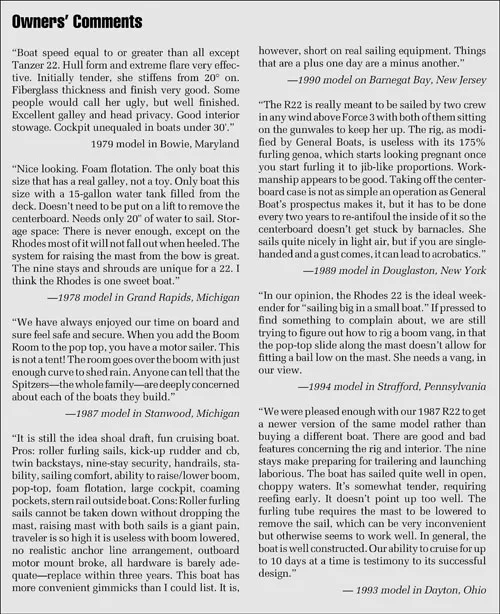
The keel is a molded-in, integral part of the hull, eliminating problems of keelbolts as well as reinforcing the boat’s bottom. Inside, there’s a separately molded centerboard trunk, and 630 lbs. of encapsulated-shot ballast. The centerboard’s pivot is inside the boat and can’t leak; the 70-lb. centerboard requires no hold-down line while sailing, but is still light enough to be raised by a braided pennant and secured with a cleat. It’s made of molded fiberglass with some ballast inside.
Hardware is of good quality throughout. Cleats, for instance, are four-bolt 10″ stainless steel open base models; hand rails, including a unique one at the aft end of the cabin trunk, are stainless steel, though teak is available. Winches are made by Lewmar.
Working on the theory that most cruisers spend much of their time in the cockpit, the Rhodes 22 was designed with a huge cockpit that’s 7′ 4″ long and nearly 8′ wide. It’s self-bailing, with a full-length bench seat on each side. The benches have open fronts, which makes for comfortable seating (closed-front benches force you to keep your legs extended), are independently self-bailing, and there’s room underneath for plastic storage bins. Aft, there’s a transverse bench covering a lazarette, which opens to a 6′ wide area that provides access to transom-mounted hardware as well as a great deal of storage space.
The coamings, which function as backrests, have a pair of compartments, each with two shelves. The flared gunwales are comfortable for hiking out. And there’s a socket in the sole so that a table can be moved from belowdecks to the cockpit. The stern rail is mounted on the side decks, outboard of the coaming, to make sitting on the coaming tops more comfortable. Optional are a pair of swivel seats—complete with backrest and padded armrest on the rail—that mount on the coaming.
The cabin door is hinged horizontally halfway up, with a stainless steel piano hinge. This can be folded out to make a chart table or card table depending upon your inclinations; there’s a molded-in socket for a supporting leg. Or, you can fold the top section down to let you see what the kids are doing in the cabin. Or, you can remove the door completely and stow it inside the gunwale.
All the controls are cockpit-mounted and fall readily to hand. The roller furling control line for the genoa is cleated on the cabin top. The mainsail roller furling is controlled by the outhaul and a control line that passes through the boom, with boom-mounted cleats. The boom can be raised via a topping lift to clear the pop-top, or lowered to reduce heeling. There is no vang, which is unfortunate.
The jib sheets run through adjustable track-mounted blocks to a pair of winches located aft so that they can be handled conveniently by the helmsman for single-handing. The traveler is very unique. It rides on a stainless steel rod mounted transversely across the twin backstays. The mainsheet cleat is mounted on the traveler block; the traveler controls are at the ends of the rod. This arrangement, odd as it may look, keeps the traveler from intruding into the cockpit space, and provides a bit of shock absorption in case of an accidental jibe. We tried it, and it works.
The tiller swings up for stand-up sailing or for easier maneuvering around the cockpit. A hiking stick lets one sail the boat from just about anywhere in the cockpit or up on the coamings, and there are even a pair of clips mounted on the aft rail that hold the tiller in any position in which it is set. The rudder kicks up if it strikes an obstruction, and can be adjusted to provide as heavy or as light a helm as you prefer.
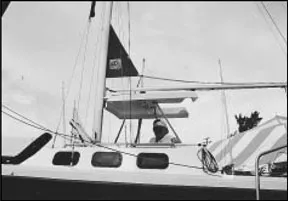
The cabin top features a pop-top with 6′ 4″ headroom; when down, there’s about 50″ of sitting headroom. The boat can be sailed with the top in either position.
Like so many other pieces of equipment on the Rhodes 22, the pop-top is a unique design. Unlike most pop-tops, which are supported by pivoting arms, the aft section of the Rhodes 22’s top is supported by a pair of telescoping stainless steel tubes, with spring-loaded detents. To raise the top, you start by lifting the rear portion—lifting only half the top’s weight—until the detents lock into position. A fitting on the forward edge of the pop-top rides in the mast’s sail slot.
There are two side-by-side opening hatches in the deck forward of the pop-top, one above the head and one above the dinette. There’s no gasket between the pop-top and the rest of the cabin—a generous overhang and deep lip allow air to circulate and prevent water leaks. The sliding companionway hatch has a built-in key lock.
The cabin layout of the Rhodes 22 is roomy and remarkably livable. It is, in large part, a tribute to the idea of making a firm decision about what you want a boat to be, and then resisting all temptations to make it something else. The Rhodes 22 is a cruiser for a couple, with possibly several youngsters.
Sleeping accommodations for the couple consist of a 6′ 6″ double berth on the port side of the dinette area; the secondary bunks consist of 6′ V-berths. If you need more sleeping room than this, there’s an optional boom-supported canopy system that General Boats calls a “Boom Room.” It converts the cockpit to a standing-headroom second cabin with a padded floor, and provides luxurious camp-aboard accommodations, though with minimal privacy.
When the dinette berth isn’t in use, half the “mattress” sections become backrest cushions for a settee, while a rotating, telescoping-base table that helps form the center section can be raised to table height and used in the dinette, or moved out to the cockpit, or stored in tracks under the forward deck.
The galley and head are on the starboard side. The galley features a 4-1/2′ counter containing a sink, stove and a large, front-opening icebox with adjustable shelves and an ice-water tap. There’s a large open storage shelf just below the portlights, and a deep cabinet just below that. There’s more storage underneath the counter. Built into the face of the top shelf are 12-volt DC and 110-volt AC outlets. Access to plumbing and electrical connections is good.
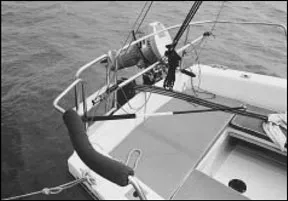
Spitzer (who has a weakness for puns) describes the Rhodes 22’s head as The Swell Head. When we compare it to the primitive accommodations on most small cruisers, we must agree. It’s fully enclosed, with a clever multi-paneled door that opens up to provide a large, non-claustrophobic space, or closes to occupy a minimum of floor space when it’s not in use. Inside, there’s a marine toilet, with sea cock-controlled water intake, holding tank and fittings for dockside pump-out or macerated discharge.
Inside, there is a mirror, cosmetic shelf, toilet paper holder, medicine cabinet, towel rack, magazine rack lighting and a 110-volt outlet for a hairdryer or electric shaver. The sole is tiled. For showering, Spitzer suggests that you take a solar-heated shower in the self-bailing cockpit. The head can be accessed from either the dinette or the V-berths.
The large hatch over the head, aside from providing ventilation and light, performs another function when the pop-top is down. If the 50″ of headroom isn’t enough to permit convenient use of the head, you can open the hatch and let your upper body emerge—presumably with a relieved smile—while you use the head in relative privacy.
Miscellaneous
The Rhodes 22 has so many gadgets that it’s hard to list them all. One particularly nice one is its adjustable motor mount. Instead of the usual recalcitrant jointed aluminum affair, it slides up and down on a pair of low-friction plastic tracks on the port side of the transom. To raise the engine, you pull a rope lanyard that passes through a 6:1 purchase magic box—almost no effort, and excellent position control. There’s a three-step boarding ladder attached to the starboard side of the transom.
Performance
We took the Rhodes 22 out on a breezy day—18-20 knots, with a 1′-3′ chop. Getting underway was as easy as advertised; we started out with the full 175% genoa and full main.
The boat is initially tender, but stiffens up quickly as it heels. The flared gunwales make hiking-out easy (and not particularly demanding athletically); putting two people on the rail did a great deal towards flattening out the ride. We suspect that if we’d been single-handing the boat, we would have reduced sail, just to help keep the boat sailing on her lines.
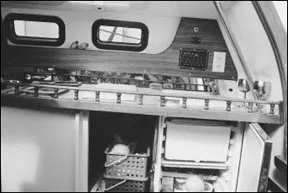
The Rhodes sailed nicely with the board down, and presentably with it up, though pointing ability naturally suffered.
We tried sailing the boat under jib alone, which worked fine, with no problems tacking. We did the same under main alone with similar results. As with any boat, the more a sail is furled, the poorer its shape; after about 30% has been furled, ideally you’d switch to as smaller sail. But when you’re starting with a 175% genoa, you’ll still have a lot of sail up even after furling a third.
In any case, we found the Rhodes 22 to be a lively-feeling boat that’s fun to sail, which is probably more important in a cruiser than absolute speed. The hull is fast, especially off the wind. The Rhodes has a PHRF rating of about 258, which is a bit faster than, say, the Catalina 22 (270), the O’Day 22 (279) or the Chrysler 22 (282) It’s by no means a racing boat (the J-22 has a rating of 177).
The Rhodes 22 is an easy boat to sail, with enough basic adjustments to satisfy most sailors, though we do wish for a boom vang. Controls are very well laid out for sailing from just about anywhere in the cockpit, though we’d like to see foot rests or toe straps to help keep the skipper and crew from sliding about in the large open cockpit.
Conclusions
It’s nice to see a boat that does what it’s intended to do as well as the Rhodes 22 does. It’s a cruiser, and packs a lot of cruising capability into a small trailerable boat. You can daysail it, obviously, but it’s really on the pricey side if a daysailer is all you want. Andyou can squeeze some more adults aboard for cruising, but at the expense of comfort, privacy or both. As a cruiser for two, it’s hard to beat without going up considerably in size and price. The reports we’ve received from readers are almost universally enthusiastic.
General sells the Rhodes 22 in a variety of models, depending upon equipment, from $19,000 to $29,000. General Boats has a buy-back policy for used boats, so that factory-reconditioned models are available, at prices starting from about $10,000.
RELATED ARTICLES MORE FROM AUTHOR
Leave a reply cancel reply.
Log in to leave a comment
Latest Videos

Island Packet 370: What You Should Know | Boat Review

How To Make Starlink Better On Your Boat | Interview

Catalina 380: What You Should Know | Boat Review
- Privacy Policy
- Do Not Sell My Personal Information
- Online Account Activation
- Privacy Manager
Category : DS-22
Media in category "ds-22".
This category contains only the following file.

- Diller-Schwill Yachts
- Sailing keelboats
- Sailing yachts by class
- Uses of Wikidata Infobox
Navigation menu
DS-22 (Q30643491)

Identifiers
Wikipedia (1 entry).
- enwiki DS-22
Wikibooks (0 entries)
Wikinews (0 entries), wikiquote (0 entries), wikisource (0 entries), wikiversity (0 entries), wikivoyage (0 entries), wiktionary (0 entries), multilingual sites (1 entry).
- commonswiki Category:DS-22
Navigation menu

IMAGES
VIDEO
COMMENTS
A boat with a BN of 1.6 or greater is a boat that will be reefed often in offshore cruising. Derek Harvey, "Multihulls for Cruising and Racing", International Marine, Camden, Maine, 1991, states that a BN of 1 is generally accepted as the dividing line between so-called slow and fast multihulls.
The DS-22 is a Canadian trailerable sailboat, that was designed by Bruce Kirby and first built in 1983. The DS-22 is a development of the 1976 Vision 660. Production. The boat was built by Diller-Schwill in Odessa, Ontario, Canada, but it is now out of production. Design. The DS ...
DS-22 is a 21′ 8″ / 6.6 m monohull sailboat designed by Bruce Kirby and built by DS Yachts (Schwill Yachts) starting in 1983. ... The lower a boat's ratio is, the less power it takes to drive the boat to its nominal hull speed or beyond. Read more. Formula. D/L = (D ÷ 2240) ÷ (0.01 x LWL)³ D: Displacement of the boat in pounds ...
The Ds 22 is a 21.67ft masthead sloop designed by Bruce Kirby and built in fiberglass by DS Yachts (Schwill Yachts) (CAN) since 1983. The Ds 22 is a light sailboat which is a good performer. It is stable / stiff and has a low righting capability if capsized. It is best suited as a day-boat.
DS 22 Sailboat for sale with trailer. Main, Genoa (furling), Spinnaker (with dousing sock), Spinnaker pole, main sail cover, danforth chain & rode, pop-top with canvas, sink, alcohol stove, head with deck pump-out, VHF, depth sounder, 9.9 Evenrude, new battery, swing keel, and numerous other miscellaneous boating items. ...
For what it's worth, the DS-22 was built by DS Yachts in Odessa, Ontario (Not far from where I live!) Also at times called Schwill Yachts and owned by Herman Schwil. Shop is no longer there and I have not heard of Herman for quite a while. Not sure if he is still with us. They also built a number of other boats.
The DS-22 is a Canadian trailerable sailboat, that was designed by Bruce Kirby and first built in 1983. [1] [2] [3] The DS-22 is a development of the 1976 Vision 660.
The Vision 660 aka Ds 22 is a small sailboat designed by the Canadian maritime architect Bruce Kirby in the mid seventies. Less than 100 boats have been produced. ... The theoretical maximal speed of a displacement boat of this length is 5.8 knots. The term "Theoretical Maximum Hull Speed" is widely used even though a boat can sail faster.
Rating (PHRF-LO) : 252. Price range: $7,000 to $9,000. The DS 22 was originally marketed as the Vision 660 and built in Winnipeg. Also noteworthy is that this boat was designed by Bruce Kirby, who gained fame by drawing the lines of the Laser dinghy. The DS 22 is good looking boat with a swing keel and sensible cabin layout.
The Ds 22 is equipped with a centerboard keel. A centerboard keel is a pivoting lifting keel, allowing to sail both coastal and inland waters. The boat can enter even shallow marinas as the draft is just about 0.61 - 0.71 meter (2.00 - 2.30 ft) dependent on the load.
DS Yachts (Schwill Yachts) (CAN) Founded by Herman Schwill. Original contact information: Schwill Yachts. Factory St., Odessa, Ontario CAN. No longer in business. Years in Business: 1971 - 1986.
Sailboat Added 07-Jun-2012 More Details. Featured Sailboats (all): 33' Precision Boat Works 11 Meter. South Lake Tahoe, California. Asking $15,000. 41' K&K Custom. Vancouver. Asking $40,000. 29.92' Catalina 30 Sloop.
The 1989 DS DS-22 sailboat has a fiberglass hull and has an overall length of 21.67 feet (sometimes referred to as LOA). The width (or beam) of this craft is 80 inches. This boat is rigged as a Sloop. The sail area for the sailboat is 235 square feet. The displacement for the boat is approximately 2250 lbs.
The boat can be sailed with the top in either position. Like so many other pieces of equipment on the Rhodes 22, the pop-top is a unique design. Unlike most pop-tops, which are supported by pivoting arms, the aft section of the Rhodes 22's top is supported by a pair of telescoping stainless steel tubes, with spring-loaded detents. ...
This page was last edited on 29 June 2019, at 20:08. Files are available under licenses specified on their description page. All structured data from the file ...
DS-22 (Q30643491) From Wikidata. Jump to navigation Jump to search. sailboat class. edit. Language Label Description Also known as; English: DS-22. sailboat class. Statements. instance of. sailboat class. 0 references. subclass of. monohull. 1 reference. Wikimedia import URL.
Owners of DS22 or Vision 660 Sailboat. 1 post • Page:1 of 1. Owners of DS22 or Vision 660 Sailboat. by Andrew Sco » Fri, 02 Dec 1994 06:35:22 . I would like to hear back from anyone who might have either a Vision 660 (fisrt generation of a DS22) or a DS22 sailboat. These are a Bruce Kirby design.
DS-16. DS-16 with the shallow draft fixed keel, on its road trailer. The DS-16 is a small recreational keelboat, built predominantly of fiberglass, with wood trim. It has a fractional sloop rig, a transom-hung rudder and a fixed shallow draft keel or optionally a centreboard. It displaces 500 lb (227 kg) and carries 135 lb (61 kg) of ballast.
The boat was built by CS Yachts in Canada. The company produced 500 CS 22s between 1971 and 1976, when production ended. Design CS 22. The CS 22 is a small recreational sailboat, built predominantly of fibreglass, with wood trim. It has a fractional sloop rig, a transom-hung rudder and a retractable centreboard with a stub keel. It displaces ...
The S2 22 is an American trailerable sailboat that was designed by Don Wennersten and Graham & Schlageter as a cruiser and first built in 1985. The S2 22 is derived from the 1983 Graham & Schlageter-designed S2 6.9, which itself was a development of the 1980 Wennersten S2 6.7 design.
S&S design #2090. Designed as IOR 1/4 ton. (18.0) Some versions had a keel/cb (as shown here). The rudder design was changed over time. Thanks to Greg, a former D&M 22 owner, for offering the following comment about the depth of the rudder: "Draft. 3.6ft (the keel) to 4.6ft (rudder) The rudder slides up a long pin prior to grounding which is ...
A boat's actual draft is usually somewhat more than the original designed or advertised draft. For boats with adjustable keels (centerboards, daggerboards, lifting and swing keels), Draft (max) is with the board down. Draft (min) is with the board up. DISPLACEMENT: If you weigh the boat on a scale, that is her actual displacement. It is the ...